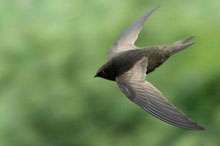No products in the cart.
Mystery Bird

In Search of the Black Swift
By Mike Blackbird
In mid-July, my birding companion, Theresa Potts, and I made our annual land odyssey to Shadow Falls in the Coeur d’Alene National Forest, in pursuit of arguably the most mysterious avian species on the continent, the black swift (Cypseloides niger).
The bird has enormous eyes, lustrous gray-black body feathers, and its curved wings measure six-and-a-half inches, weighing all of an ounce-and-a-half. This is especially amazing when you consider that three migrating Colorado black swifts fitted with geolocators were tracked 8,600 miles round trip to a lowland rainforest in northwestern Brazil.
All swift species have extremely short legs, inspiring their family name Apodidae, which means “weak feet.” Consequently, they cannot perch and are the most aerial of birds, spending most of their lives on the wing. They forage for winged insects, bathe, drink, mate, and even sleep in the air.
Black swifts are mysterious and elusive, because they generally forage for flying insects at high altitude and accordingly are rarely seen. Contributing to their elusiveness is that they nest on inaccessible sea cliffs or, when they’re inland, near or behind waterfalls.
This content is available for purchase. Please select from available options.
Register & Purchase Purchase Only
Register & Purchase Purchase Only


Comments are closed.